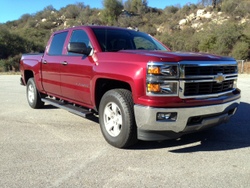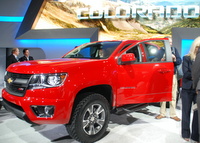A New Front Opens In The Truck Wars

You’d be forgiven if you thought a pickup truck owner sounded like a proud parent when discussing his(or her) truck. Oh, the things they can do, the feats of power and might. The versatility, unexpected surprises of comfort and utility. They are things of beauty, though that beauty might need to be experienced to be appreciated.
Keep your ears tuned to those conversations (and they are many since full-size pickup trucks remain the most popular and best-selling vehicles in the U.S.), because we suspect the bragging rights are about to change. Where it was how easily you could tow or how much you could haul, you are going to begin to hear pickup owners wax eloquent about fuel economy and pick up MPG attained – while still doing all those things that pickups are designed to do.
This change in the dialogue is being driven by a couple different issues. First, of course, is that fuel prices aren’t getting any lower. While not as high as the spike of a couple years ago, $3 and $4 gas and diesel has become the norm and doesn’t show any sign of decline. Second, the government is pushing automakers to boost the fuel economy of all their vehicles and trucks are having their turn. More detail on this later, but suffice it to say that the desire to reduce petroleum use in this country has to start with big pickups. Because they’re so popular and historically have not been very fuel efficient, they use a disproportionate amount of gas and diesel. Conversely, relatively small numerical increases in MPG can reap very positive fuel savings.
When we’re talking about pickups, the sweet spot is the half-ton pickup, designated as a usually 150 or 1500 by the Detroit Three, and indicator of the nominal payload capacity of 1500 pounds. Ford, Chevy, GMC Truck and Ram all have heavier duty models as well, but their sales volume is with the half-tons. With the Toyota and Nissan pickups, all their offerings are in the half-ton realm.
Here’s some chronology of the changes in technology that are feeding the focus on fuel economy in trucks.
Ford was first to throw down the gauntlet when it began offering its EcoBoost engines in the F-150. Skeptics said the pickup buyers would scoff at a V6 as inadequate for a real truck, possibly an insult to the manhood of anyone found driving one. The market did not think so and the EcoBoost became one of the more popular engine options, picked by about one-third of F-150 buyers. The EcoBoost has been so popular that for the 2015 model Ford will offer a second, even smaller version of the turbocharged, direct-injected engine. Ford’s advanced engines pushed highway fuel economy into the mid-twenties, rarefied atmosphere for a full-size pickup.

Not to be outdone, Ford’s big rival Chevrolet redesigned its Silverado pickup for 2014 and dropped in a V8 that they claimed would best the EcoBoost V6 in fuel economy. It may have only been one MPG, but bragging rights are bragging rights in the truck market. The bottom line with both Ford and GM was that pickup engines were now featuring all of the advanced technology formerly reserved for sedans. Clean Fleet Report just finished a road test of the Silverado and found it was efficient and didn’t sacrifice any of its capabilities. We also noted that during this efficiency focus the industry has also pumped up the interior comfort of these workhorse vehicles.

Over at Ram they weren’t standing still, which may be why Ram pickups are sneaking up on Chevy in sales (Ford has held the top spot for more than three decades). Ram’s V6 topped all of the engines from its cross-town rivals. They mated both the V6 and V8 engines to an 8-speed transmission and with the venerable Hemi V8 Ram’s featured MDS (Multi-Displacement System), which deactivates cylinders of the engine when they aren’t needed to save fuel.
Ram upped the ante last year by announcing it was adding the first modern diesel in the half-ton market to its 1500 early this year (2014). Those are just about to arrive at dealerships. The 3.0-liter V6 will deliver an EPA estimated 28 MPG on the highway while maintaining hauling and towing capacities. It also just took honors as one of Wards Magazine’s Top 10 Engines of 2014.
The latest effort in this arena was just presented at last month’s Detroit Auto Show. Ford showcased a complete rethinking of the F-150, wringing a 15 percent weight reduction by going to an aluminum body and high-strength steel chassis. With the reduction in overall weight, they were able to add a second, smaller EcoBoost V6 as noted above. They also incorporated Auto Start-Stop in what appears to be an all-out effort to take the top MPG crown in the pickup field. Official fuel economy numbers for the new 2015 F-150 with the 2.7-liter EcoBoost engine haven’t been announced yet, but the story is clear.

On the horizon, we expect to see more MPG-boosting technologies applied to the truck market. Some have already been set to go into motion. Toyota showed a version of its Tundra pickup with a hybrid badge sometime ago, but hasn’t applied that technology to a truck–yet. Nissan has already announced it is dropping a Cummins V8 diesel into the Titan pickup and showed off a V6 diesel-powered Frontier pickup at the Chicago Auto Show this month. GM has announced next year its Colorado and Canyon midsize pickups will feature V6 diesels.
Fuel economy has never been a more important story in the pickup market, which is why Clean Fleet Report will be covering this segment along with the others. It’s going to be a fun ride.
Story by Michael Coates; photos by Michael Coates, John Faulkner & the manufacturers
Posted Feb. 15, 2014
Other Related Stories You Might Enjoy:
Road Test: 2014 Chevrolet Silverado
Ford Sees The Way To MPG Through Lightweighting
10 Best Engines Named By Magazine

It looks like Ford has pushed some serious buttons in the pickup world with its aluminum moves. Reports this week from the Wall Street Journal indicate GM is rushing to add more aluminum to their Chevy and GMC pickups, although they won’t be able to get them into production for several years. –ed. Michael Coates